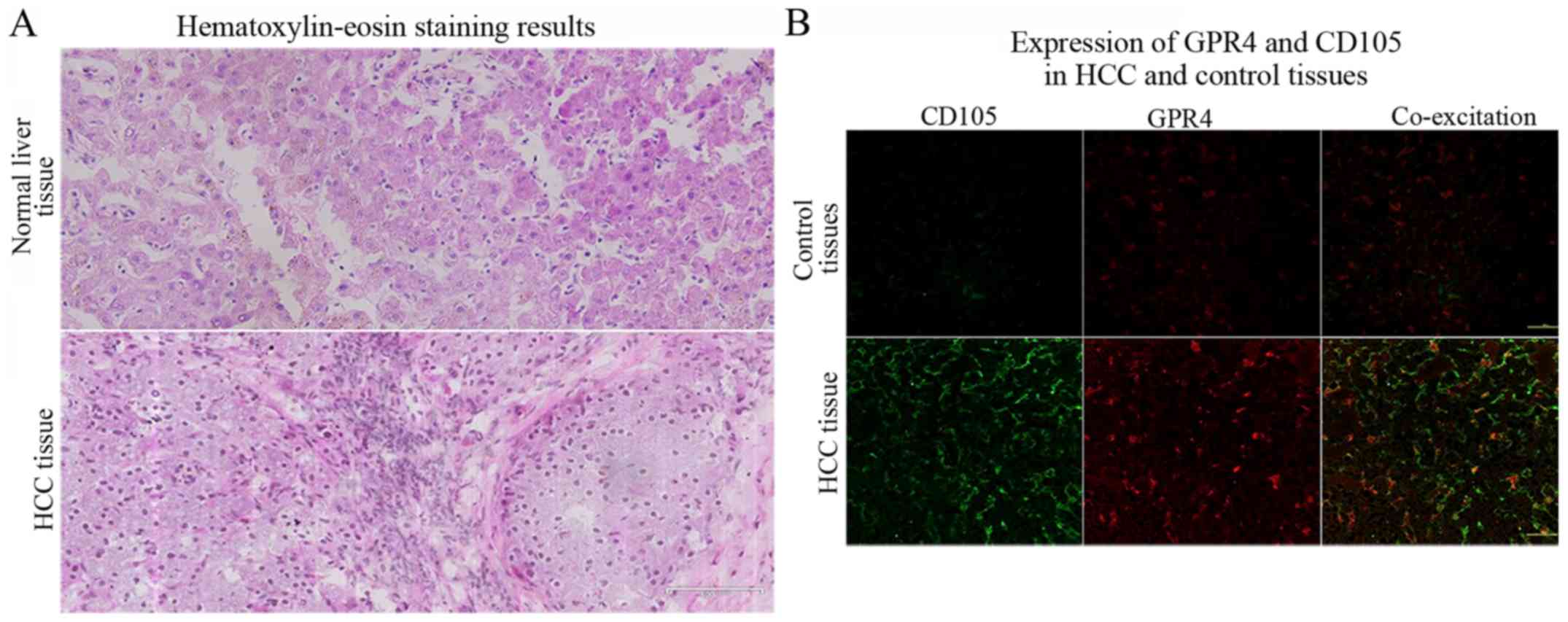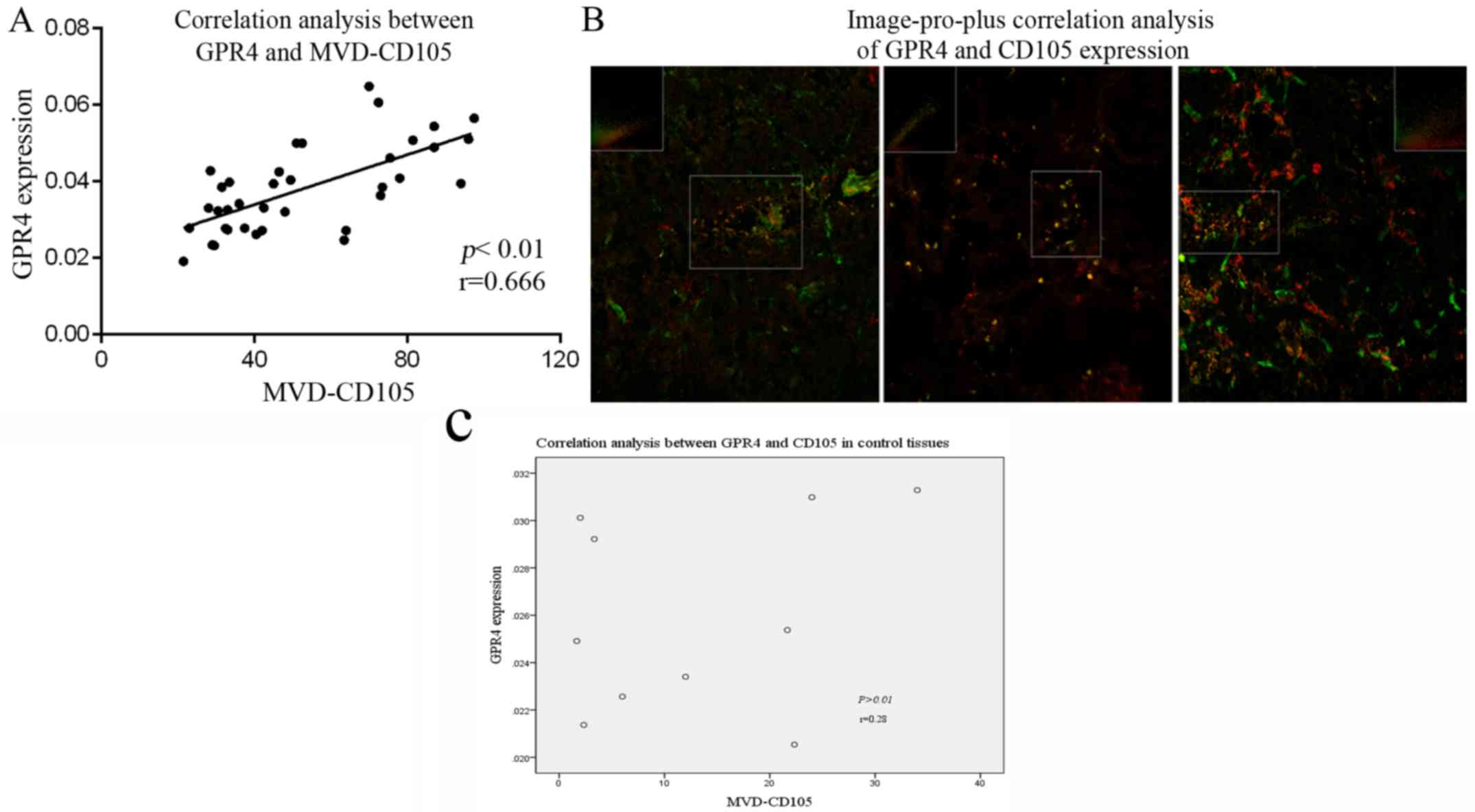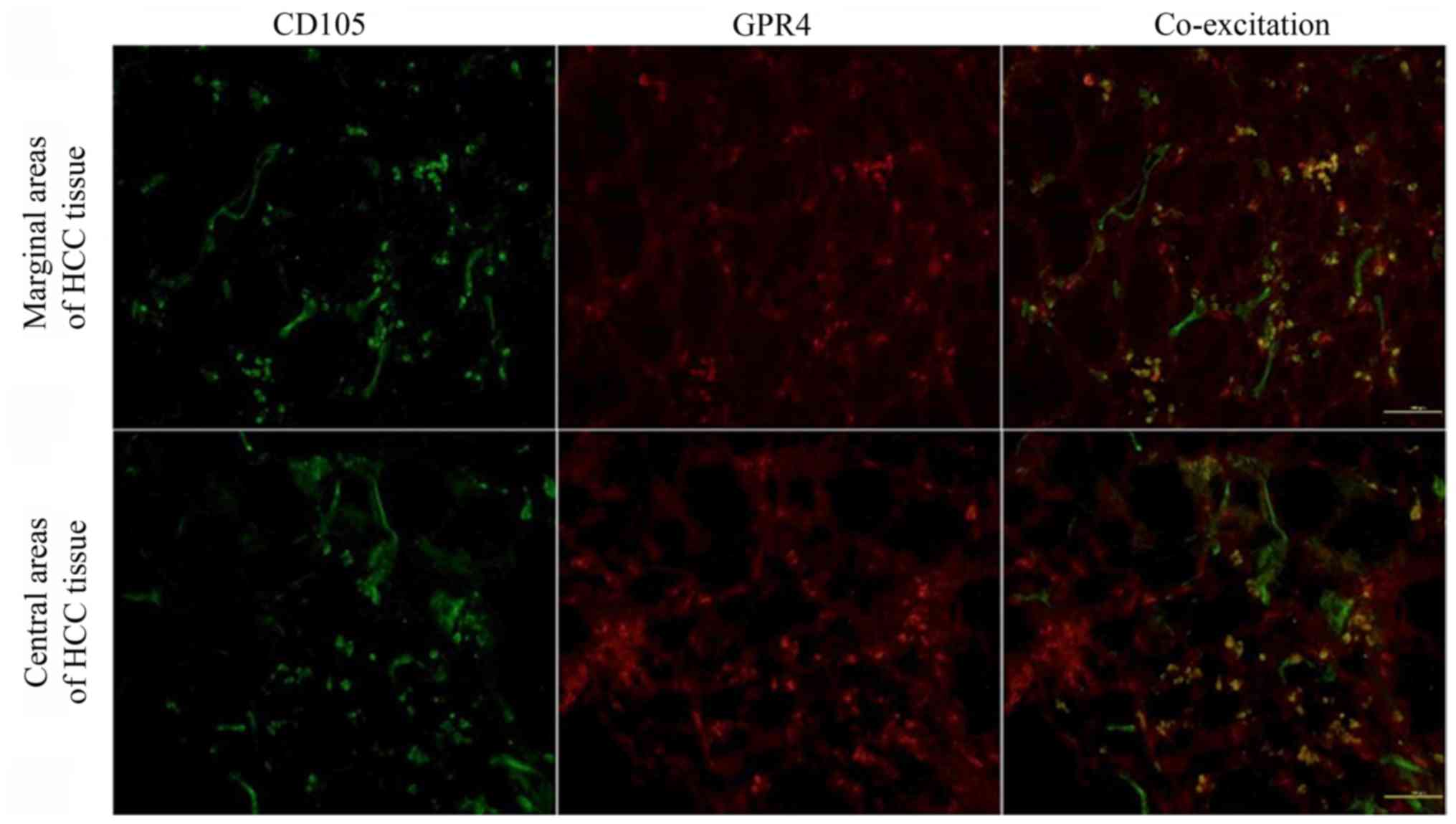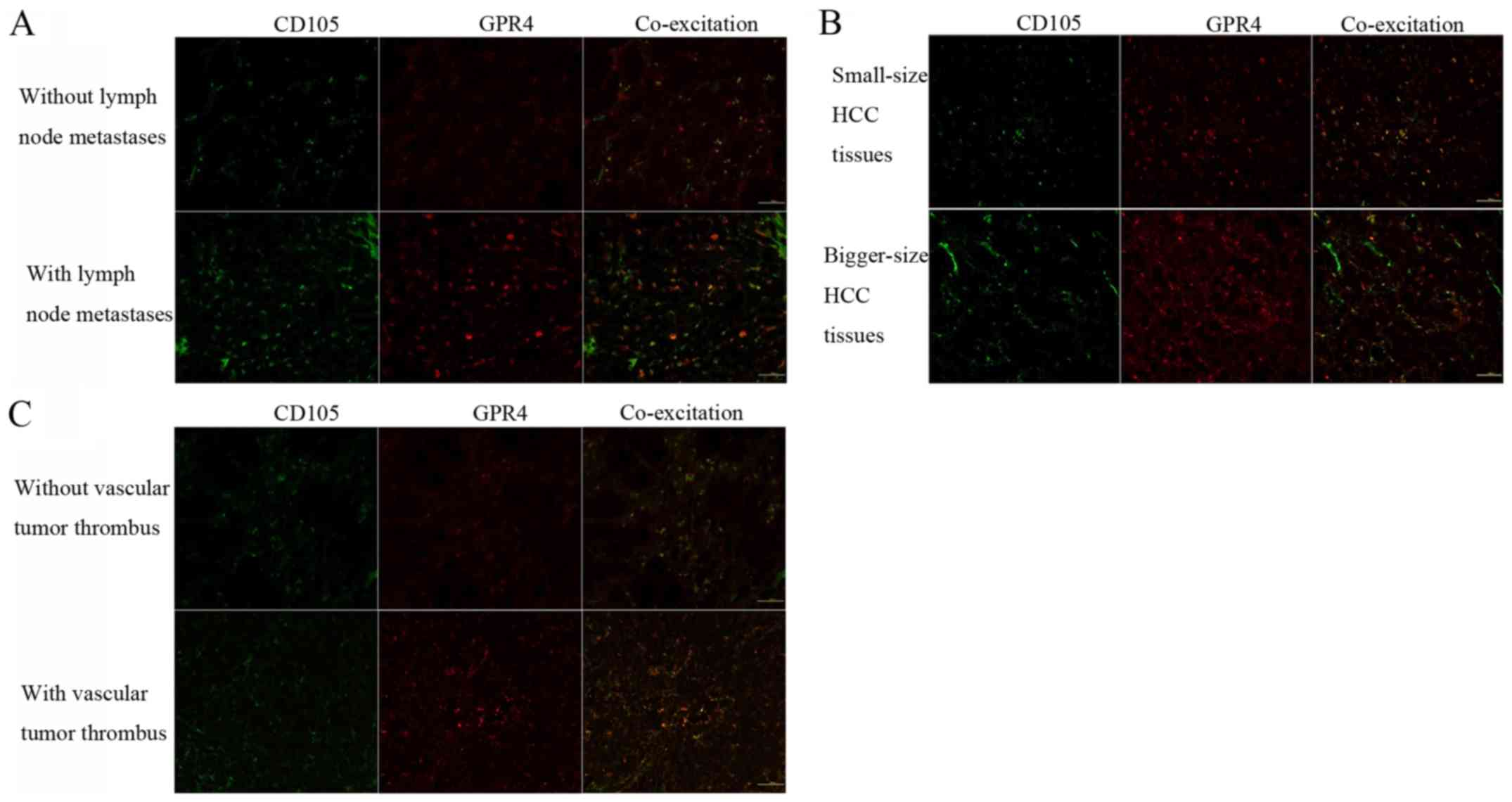|
1
|
Ludwig MG, Vanek M, Guerini D, Gasser JA,
Jones CE, Junker U, Hofstetter H, Wolf RM and Seuwen K:
Proton-sensing G-protein-coupled receptors. Nature. 425:93–98.
2003. View Article : Google Scholar : PubMed/NCBI
|
|
2
|
Liang B, Lei W and Gaole A: Relationship
between proton-sensing G-protein coupled receptors and
tumorigenesis and tumor metastasis. Chin J Biochem Mol Biol.
2011.(In Chinese).
|
|
3
|
Murakami N, Yokomizo T, Okuno T and
Shimizu T: G2A is a proton-sensing G-protein-coupled receptor
antagonized by lysophosphatidylcholine. J Biol Chem.
279:42484–42491. 2004. View Article : Google Scholar : PubMed/NCBI
|
|
4
|
Wang JQ, Kon J, Mogi C, Tobo M, Damirin A,
Sato K, Komachi M, Malchinkhuu E, Murata N, Kimura T, et al: TDAG8
is a proton-sensing and psychosine-sensitive G-protein-coupled
receptor. J Biol Chem. 279:45626–45633. 2004. View Article : Google Scholar : PubMed/NCBI
|
|
5
|
Mahadevan MS, Baird S, Bailly JE, Shutler
GG, Sabourin LA, Tsilfidis C, Neville CE, Narang M and Korneluk RG:
Isolation of a novel G protein-coupled receptor (GPR4) localized to
chromosome 19q13.3. Genomics. 30:84–88. 1995. View Article : Google Scholar : PubMed/NCBI
|
|
6
|
Justus CR, Dong L and Yang LV: Acidic
tumor microenvironment and pH-sensing G protein-coupled receptors.
Front Physiol. 4:3542013. View Article : Google Scholar : PubMed/NCBI
|
|
7
|
Ren J, Zhang Y, Cai H, Ma H, Zhao D, Zhang
X, Li Z, Wang S, Wang J, Liu R, et al: Human GPR4 and the notch
signaling pathway in endothelial cell tube formation. Mol Med Rep.
14:1235–1240. 2016. View Article : Google Scholar : PubMed/NCBI
|
|
8
|
Kim KS, Ren J, Jiang Y, Ebrahem Q, Tipps
R, Cristina K, Xiao YJ, Qiao J, Taylor KL, Lum H, et al: GPR4 plays
a critical role in endothelial cell function and mediates the
effects of sphingosylphosphorylcholine. FASEB J. 19:819–821. 2005.
View Article : Google Scholar : PubMed/NCBI
|
|
9
|
Jing Z, Xu H, Chen X, Zhong Q, Huang J,
Zhang Y, Guo W, Yang Z, Ding S, Chen P and Huang Z: The
proton-sensing G-protein coupled receptor GPR4 promotes
angiogenesis in head and neck cancer. PLoS One. 11:e01527892016.
View Article : Google Scholar : PubMed/NCBI
|
|
10
|
Ren J, Jin W, Gao YE, Zhang Y, Zhang X,
Zhao D, Ma H, Li Z, Wang J, Xiao L, et al: Relations between GPR4
expression, microvascular density (MVD) and clinical pathological
characteristics of patients with epithelial ovarian carcinoma
(EOC). Curr Pharm Des. 20:1904–1916. 2014. View Article : Google Scholar : PubMed/NCBI
|
|
11
|
Wyder L, Suply T, Ricoux B, Billy E,
Schnell C, Baumgarten BU, Maira SM, Koelbing C, Ferretti M, Kinzel
B, et al: Reduced pathological angiogenesis and tumor growth in
mice lacking GPR4, a proton sensing receptor. Angiogenesis.
14:533–544. 2011. View Article : Google Scholar : PubMed/NCBI
|
|
12
|
Yang LV, Radu CG, Roy M, Lee S, McLaughlin
J, Teitell MA, Iruela-Arispe ML and Witte ON: Vascular
abnormalities in mice deficient for the G protein-coupled receptor
GPR4 that functions as a pH sensor. Mol Cell Biol. 27:1334–1347.
2007. View Article : Google Scholar : PubMed/NCBI
|
|
13
|
Sin WC, Zhang Y, Zhong W, Adhikarakunnathu
S, Powers S, Hoey T, An S and Yang J: G protein-coupled receptors
GPR4 and TDAG8 are oncogenic and overexpressed in human cancers.
Oncogene. 23:6299–6303. 2004. View Article : Google Scholar : PubMed/NCBI
|
|
14
|
Honda H, Tajima T, Kajiyama K, Kuroiwa T,
Yoshimitsu K, Irie H, Aibe H, Shimada M and Masuda K: Vascular
changes in hepatocellular carcinoma: Correlation of radiologic and
pathologic findings. AJR Am J Roentgenol. 173:1213–1217. 1999.
View Article : Google Scholar : PubMed/NCBI
|
|
15
|
Matsui O, Kobayashi S, Sanada J, Kouda W,
Ryu Y, Kozaka K, Kitao A, Nakamura K and Gabata T: Hepatocelluar
nodules in liver cirrhosis: Hemodynamic evaluation
(angiography-assisted CT) with special reference to multi-step
hepatocarcinogenesis. Abdom Imaging. 36:264–272. 2011. View Article : Google Scholar : PubMed/NCBI
|
|
16
|
Hui LI, Qing YE, Yin XJ and Li YM: The
research of angiogenesis in hepatocellular carcinoma. Chin Clin
Oncol. 4:2009.(In Chinese).
|
|
17
|
Yamamoto K: Clinical management of
hepatocellular carcinoma. J Okayama Med Association. 120:279–284.
2008.
|
|
18
|
Kin M, Torimura T, Ueno T, Inuzuka S and
Tanikawa K: Sinusoidal capillarization in small hepatocellular
carcinoma. Pathol Int. 4:771–778. 1994.
|
|
19
|
Peng WT, Sun WY, Li XR, Sun JC, Du JJ and
Wei W: Emerging roles of G protein-coupled receptors in
hepatocellular carcinoma. Int J Mol Sci. 19:13662018. View Article : Google Scholar
|
|
20
|
Chen Y, Teng F, Wang G and Nie Z:
Overexpression of CXCR7 induces angiogenic capacity of human
hepatocellular carcinoma cells via the AKT signaling pathway. Oncol
Rep. 36:2275–2281. 2016. View Article : Google Scholar : PubMed/NCBI
|
|
21
|
Nassiri F, Cusimano MD, Scheithauer BW,
Rotondo F, Fazio A, Yousef GM, Syro LV, Kovacs K and Lloyd RV:
Endoglin (CD105): A review of its role in angiogenesis and tumor
diagnosis, progression and therapy. Anticancer Res. 31:2283–2290.
2011.PubMed/NCBI
|
|
22
|
Kumar S, Ghellal A, Li C, Byrne G, Haboubi
N, Wang JM and Bundred N: Breast carcinoma: Vascular density
determined using CD105 antibody correlates with tumor prognosis.
Cancer Res. 59:856–861. 1999.PubMed/NCBI
|
|
23
|
Fonsatti E, Altomonte M, Nicotra MR,
Natali PG and Maio M: Endoglin (CD105): A powerful therapeutic
target on tumor-associated angiogenetic blood vessels. Oncogene.
22:6557–6563. 2003. View Article : Google Scholar : PubMed/NCBI
|
|
24
|
Dallas NA, Samuel S, Xia L, Fan F, Gray
MJ, Lim SJ and Ellis LM: Endoglin (CD105): A marker of tumor
vasculature and potential target for therapy. Clin Cancer Res.
14:1931–1937. 2008. View Article : Google Scholar : PubMed/NCBI
|
|
25
|
Fonsatti E, Nicolay HJ, Altomonte M, Covre
A and Maio M: Targeting cancer vasculature via endoglin/CD105: A
novel antibody-based diagnostic and therapeutic strategy in solid
tumours. Cardiovasc Res. 86:12–19. 2010. View Article : Google Scholar : PubMed/NCBI
|
|
26
|
Robboy SJ: Surgical Pathology Dissection,
an Illustrated Guide. International Journal of Gynecological
Pathology. 16–86. 1997.
|
|
27
|
Edge SB and Compton CC: The American joint
committee on cancer: The 7th edition of the AJCC cancer staging
manual and the future of TNM. Ann Surg Oncol. 17:1471–1474. 2010.
View Article : Google Scholar : PubMed/NCBI
|
|
28
|
Chen A, Dong L, Leffler NR, Asch AS, Witte
ON and Yang LV: Activation of GPR4 by acidosis increases
endothelial cell adhesion through the cAMP/Epac pathway. PLoS One.
6:e275862011. View Article : Google Scholar : PubMed/NCBI
|
|
29
|
Le D: Tumor angiogenesis and
metastasis-correlation in invasive breast carcinoma. N Engl J Med.
324:1–8. 1991. View Article : Google Scholar
|
|
30
|
Yu P, Bu H, Wang H, Zhao G, Zhang J and
Zhou Q: Comparative study on image analysis and manual counting of
immunohistochemistry. Sheng Wu Yi Xue Gong Cheng Xue Za Zhi.
20:288–290. 2003.(In Chinese). PubMed/NCBI
|
|
31
|
Henry-Berger J, Mouzat K, Baron S,
Bernabeu C, Marceau G, Saru JP, Sapin V, Lobaccaro JM and Caira F:
Endoglin (CD105) expression is regulated by the liver X receptor
alpha (NR1H3) in human trophoblast cell line JAR. Biol Reprod.
78:968–975. 2008. View Article : Google Scholar : PubMed/NCBI
|
|
32
|
Wikström P, Lissbrant IF, Stattin P,
Egevad L and Bergh A: Endoglin (CD105) is expressed on immature
blood vessels and is a marker for survival in prostate cancer.
Prostate. 51:268–275. 2002. View Article : Google Scholar : PubMed/NCBI
|
|
33
|
Darcy KM and Birrer MJ: Translational
research in the gynecologic oncology group: Evaluation of ovarian
cancer markers, profiles, and novel therapies. Gynecol Oncol.
117:429–439. 2010. View Article : Google Scholar : PubMed/NCBI
|
|
34
|
Yao Y, Pan Y, Chen J, Sun X, Qiu Y and
Ding Y: Endoglin (CD105) expression in angiogenesis of primary
hepatocellular carcinomas: Analysis using tissue microarrays and
comparisons with CD34 and VEGF. Ann Clin Lab Sci. 37:39–48.
2007.PubMed/NCBI
|
|
35
|
Tanaka F, Otake Y, Yanagihara K, Kawano Y,
Miyahara R, Li M, Yamada T, Hanaoka N, Inui K and Wada H:
Evaluation of angiogenesis in non-small cell lung cancer:
Comparison between anti-CD34 antibody and anti-CD105 antibody. Clin
Cancer Res. 7:3410–3415. 2001.PubMed/NCBI
|
|
36
|
Goldiş DS, Sferdian MF, Tarţă C, Fulger
LO, Totolici BD and Neamţu C: Comparative analysis of microvessel
density quantified through the immunohistochemistry expression of
CD34 and CD105 in rectal cancer. Rom J Morphol Embryol. 56:419–424.
2015.PubMed/NCBI
|
|
37
|
Mărgăritescu C, Simionescu C, Mogoantă L,
Badea P, Pirici D, Stepan A and Ciurea R: Endoglin (CD105) and
microvessel density in oral squamous cell carcinoma. Rom J Morphol
Embryol. 49:321–326. 2008.PubMed/NCBI
|
|
38
|
Nedergaard M, Kraig RP, Tanabe J and
Pulsinelli WA: Dynamics of interstitial and intracellular pH in
evolving brain infarct. Am J Physiol. 260:R581–R588.
1991.PubMed/NCBI
|
|
39
|
Lardner A: The effects of extracellular pH
on immune function. J Leukoc Biol. 69:522–530. 2001.PubMed/NCBI
|
|
40
|
Wahl ML and Grant DS: Effects of
microenvironmental extracellular pH and extracellular matrix
proteins on angiostatin's activity and on intracellular pH. Gen
Pharmacol. 35:277–285. 2000. View Article : Google Scholar : PubMed/NCBI
|
|
41
|
Gatenby RA and Gillies RJ: Why do cancers
have high aerobic glycolysis? Nat Rev Cancer. 4:891–899. 2004.
View Article : Google Scholar : PubMed/NCBI
|
|
42
|
Wang X and Klein RD: Prostaglandin E 2
induces vascular endothelial growth factor secretion in prostate
cancer cells through EP2 receptor-mediated cAMP pathway. Mol
Carcinog. 46:912–923. 2007. View Article : Google Scholar : PubMed/NCBI
|
|
43
|
Ristori C, Ferretti ME, Pavan B,
Cervellati F, Casini G, Catalani E, Dal Monte M and Biondi C:
Adenylyl Cyclase/cAMP System involvement in the antiangiogenic
effect of somatostatin in the retina. Results from transgenic mice.
Neurochem Res. 33:12472008. View Article : Google Scholar : PubMed/NCBI
|
|
44
|
Rozengurt E: Mitogenic signaling pathways
induced by G protein-coupled receptors. J Cell Physiol.
213:589–602. 2007. View Article : Google Scholar : PubMed/NCBI
|
|
45
|
Dong L, Krewson EA and Yang LV: Acidosis
activates endoplasmic reticulum stress pathways through GPR4 in
human vascular endothelial cells. Int J Mol Sci. 18:2782017.
View Article : Google Scholar
|
|
46
|
Dong B and Zhang X, Fan Y, Cao S and Zhang
X: GPR4 knockout improves renal ischemia-reperfusion injury and
inhibits apoptosis via suppressing the expression of CHOP. Biochem
J. 474:4065–4075. 2017. View Article : Google Scholar : PubMed/NCBI
|
|
47
|
Li C, Guo B, Wilson PB, Stewart A, Byrne
G, Bundred N and Kumar S: Plasma levels of soluble CD105 correlate
with metastasis in patients with breast cancer. Int J Cancer.
89:122–126. 2000. View Article : Google Scholar : PubMed/NCBI
|
|
48
|
Abou-Alfa GK, Amadori D, Santoro A, Figer
A, De Greve J, Lathia C, Voliotis D, Anderson S, Moscovici M and
Ricci S: Safety and efficacy of sorafenib in patients with
hepatocellular carcinoma (HCC) and child-pugh A versus B cirrhosis.
Gastrointest Cancer Res. 4:40–44. 2011.PubMed/NCBI
|
|
49
|
Branco F, Bru C, Vilana R, Bianchi L and
Alvas de Mattos AA: Percutaneous ethanol injection before liver
transplantation in the hepatocellular carcinoma. Ann Hepatol.
8:220–227. 2009. View Article : Google Scholar : PubMed/NCBI
|
|
50
|
Kawai S, Okamura J, Ogawa M, Ohashi Y,
Tani M, Inoue J, Kawarada Y, Kusano M, Kubo Y and Kuroda C:
Prospective and randomized clinical trial for the treatment of
hepatocellular carcinoma-a comparison of lipiodol-transcatheter
arterial embolization with and without adriamycin (first
cooperative study). The cooperative study group for liver cancer
treatment of Japan. Cancer Chemother Pharmacol. 31 (Suppl):S1–S6.
1992. View Article : Google Scholar : PubMed/NCBI
|
|
51
|
Lau WY, Lai EC and Leung TW: Current role
of selective internal irradiation with yttrium-90 microspheres in
the management of hepatocellular carcinoma: A systematic review.
Int J Rad Oncol Biol Phys. 81:460–467. 2011. View Article : Google Scholar
|
|
52
|
Livraghi T, Goldberg SN, Lazzaroni S,
Meloni F, Solbiati L and Gazelle GS: Small hepatocellular
carcinoma: Treatment with radio-frequency ablation versus ethanol
injection. Radiology. 210:655–661. 1999. View Article : Google Scholar : PubMed/NCBI
|
|
53
|
Nicolini A, Fasani P, Manini MA,
Martinetti L, Forzenigo LV, Iavarone M, Crespi S, Rossi G,
Biondetti P, Colombo M and Sangiovanni A: Transarterial
embolization with microspheres in the treatment of monofocal HCC.
Dig Liver Dis. 41:143–149. 2009. View Article : Google Scholar : PubMed/NCBI
|
|
54
|
Sun W: Treatment of inoperable HCC after
sorafenib: Where will the new paradigm take Us? Gastrointest Cancer
Res. 2:49–50. 2008.PubMed/NCBI
|
|
55
|
Germano G, Allavena P and Mantovani A:
Cytokines as a key component of cancer-related inflammation.
Cytokine. 43:374–379. 2008. View Article : Google Scholar : PubMed/NCBI
|
|
56
|
Sakurai T, He G, Matsuzawa A, Yu GY, Maeda
S, Hardiman G and Karin M: Hepatocyte necrosis induced by oxidative
stress and IL-1α release mediate carcinogen-induced compensatory
proliferation and liver tumorigenesis. Cancer Cell. 14:156–165.
2008. View Article : Google Scholar : PubMed/NCBI
|
|
57
|
Sun HC and Tang ZY: Angiogenesis in
hepatocellular carcinoma: The retrospectives and perspectives. J
Cancer Res Clin. 130:307–319. 2004. View Article : Google Scholar
|
|
58
|
Zhu AX: Systemic treatment of
hepatocellular carcinoma: Dawn of a new era? Ann Surg Oncol.
17:1247–1256. 2010. View Article : Google Scholar : PubMed/NCBI
|
|
59
|
Abdel-Rahman O and Cheung WY: The
expanding role of systemic therapy in the management of
hepatocellular carcinoma. Can J Gastroenterol Hepatol. 2018:1–4.
2018. View Article : Google Scholar
|



















